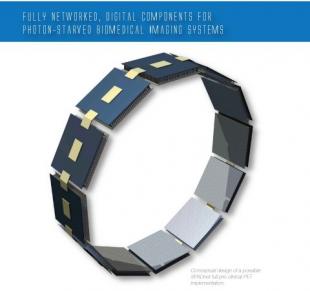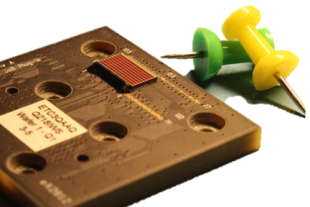SPADnet aims to develop a new generation of smart, CMOS-based large area networked image sensors for photon-starved biomedical applications, build ring-assembly modules for Positron Emission Tomography (PET) imaging, and carry out performance tests in a PET system evaluation test bed. While suited to applications offering repetitive measurement techniques, existing sensors are not well adapted to single-shot, rare events often occurring in diagnostic tools based on specific radiation detection, PET, SPECT, gamma cameras, and other minimally-invasive / point of care tools. In addition, the relatively small field-of-view of existing sensors is a limiting factor.
Project Overview Video:
Devil In The Detail Mediso Cut 2 from Spadnet TU Delft on Vimeo.
SPADnet's prime objective is to develop a scalable photonic component for large format, rare-event imaging. The core of the component will be a SPAD array implemented in CMOS. Large formats will be achieved by tessellating several tens of dies in abutment style using innovative packaging techniques based on through silicon vias (TSVs). The ability to stamp the time and position of each photon impingement in a burst event offers a second key advance. The concept of spatial oversampling is introduced, where a single measurement is partitioned into a myriad of sub-measurements, occurring simultaneously. The difference is that in space oversampling many SPADs will detect the same event independently, thus reducing the dead time on average by the number of detectors involved. The decomposition of the large format imager to a network of independent arrays is key to managing massive data streams. In conventional PMTs or SiPMs, the sensitive device produces a stream of analogue electrical pulses. The photonic component proposed in this project on the contrary generates streams of pre-computed digital data.
The current state-of-the-art on inter-chip data exchange will be the basis for efficient data communication, in a true network communication style. Data packets will be routed in the network and will be handled on-demand. For example coincidence mapping engines can be used in this context as snoopers on the data bus, thus considerably simplifying systems such as PET.
Detailed Discussion:
THE DEVIL IN THE DETAIL from Spadnet TU Delft on Vimeo.
Henderson Interview 2 from Spadnet TU Delft on Vimeo.
Further Information:
Watch a range of videos discussing the project.
Funding
European Seventh Framework Programme (FP7): €5.3, June 2010 - December 2014
Collaboration
Principal Investigator:
Postgraduate Researchers:
- Dr Richard Walker
- Dr Ahmet Erdogan
- Eric Webster




